 |
 |
 |
 |
 |
 |
| |
 |
|
 |
 |
 |
  |
  |
 |
 |
 |
 |
|
|
 |
|
 |
 |
 |
BUILDING |
 |
|
 |
|
 |
 |
 |
| |
 |
| 
 |
Humboldt-Box
|
|
 |
 |
 |
 |
DESIGNER |
 |
|
|
 |
|
 |
 |
 |
| |
 |
|
 |
 |
 |
 |
DESCRIPTION |
 |
|
|
 |
|
 |
 |
 |
| Transitory Architecture |
 |
|
 |
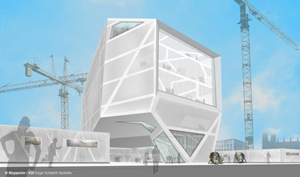 The Humboldt Box will accompany the building of the Humboldt Forum/Stadtschloss Berlin as an information and exhibition structure. As a temporary building, it will be dismantled with the completion of the Humboldt Forum after a predicted lifetime eight years. Until then, later users of the Humboldt Forum – among them the National Museums in Berlin, the Prussian Cultural Heritage Foundation as well as the Central and Regional Library Berlin – will be using the structure to provide a glimpse into their various collections. The Association for the Rebuilding of the Berliner Stadtschloss will be informing visitors about the history of the Berlin Palace, the reconstruction of the palace façade, and the historical courtyard. The Humboldt Box will accompany the building of the Humboldt Forum/Stadtschloss Berlin as an information and exhibition structure. As a temporary building, it will be dismantled with the completion of the Humboldt Forum after a predicted lifetime eight years. Until then, later users of the Humboldt Forum – among them the National Museums in Berlin, the Prussian Cultural Heritage Foundation as well as the Central and Regional Library Berlin – will be using the structure to provide a glimpse into their various collections. The Association for the Rebuilding of the Berliner Stadtschloss will be informing visitors about the history of the Berlin Palace, the reconstruction of the palace façade, and the historical courtyard.
In this sense, the Humboldt Box is a communication structure that draws on familiar elements of temporary and technical construction, as commonly seen in scaffolding, stilt houses, tents or drilling platforms.
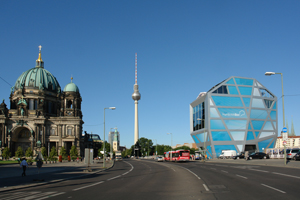 The transitory architecture will occupy a sensitive spot in the immediate vicinity of the Altes Museum, Lustgarten, and Berlin Cathedral, where the Unter den Linden avenue makes a slight turn into Spree Island. The view from the roof terrace offers an impression of the city’s size along with a surprisingly close relationship to the important places and buildings in Berlin’s historical Mitte district. With the start of construction for the underground railway and Humboldt Forum, the Humboldt Box will have to compete visually with the scaffolding and cranes that surround it. The transitory architecture will occupy a sensitive spot in the immediate vicinity of the Altes Museum, Lustgarten, and Berlin Cathedral, where the Unter den Linden avenue makes a slight turn into Spree Island. The view from the roof terrace offers an impression of the city’s size along with a surprisingly close relationship to the important places and buildings in Berlin’s historical Mitte district. With the start of construction for the underground railway and Humboldt Forum, the Humboldt Box will have to compete visually with the scaffolding and cranes that surround it.
The guidelines for the structure’s volume and purpose were described in detail in the competition announcement. The smallish building lot was tightly allocated to accommodate the larger site for the palace, and the majority of the lot was to be kept open to maintain easy access to pipeline routes. The diagonal sections traversing the allocated rectangular building area and the silhouette turn the box into a freestanding sculpture, mediating the kink in the street axis.
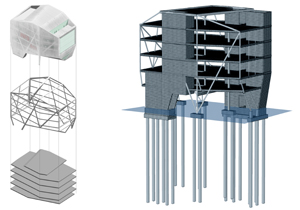 The above-ground supporting structure is a reaction to or reflection of these unique constraints: steel beams – vertical in the outer skeleton and horizontal at the ceiling-edge areas – are hung or slotted into the reinforced concrete floors and stairwells. The weight of the total of seven building levels is borne by four plinths located within the specified areas. This inevitably leads to high load concentrations that are carried by drilled shafts, whose depth (27 m) corresponds to the building height. The above-ground supporting structure is a reaction to or reflection of these unique constraints: steel beams – vertical in the outer skeleton and horizontal at the ceiling-edge areas – are hung or slotted into the reinforced concrete floors and stairwells. The weight of the total of seven building levels is borne by four plinths located within the specified areas. This inevitably leads to high load concentrations that are carried by drilled shafts, whose depth (27 m) corresponds to the building height.
The distinctive structure of the steel skeleton results from optimised force distribution; it forms the framework for the changeable surface covering and has a high recognition factor. From its construction hoarding to its alterable cladding, “frame” and “perforation” are key elements with which the notion of the “temporary” can be staged and re-staged over the entire lifecycle of the Box.
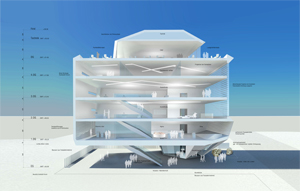 The design and technical solution of employing the textile covering as an outer shell is based on the experience of the Megaposter company, and also points to the company’s expertise in implementing unusual, large-area billboard advertisements. Between the fabric and the building’s actual, porous concrete cladding is a 30 cm gap that is lit from behind. Swapping the textile covering ␣or␣varying␣the␣colour of the light␣ – to signal new exhibition content, for example – will allow changes in the Humboldt Box’s appearance over its lifetime of several years. The design and technical solution of employing the textile covering as an outer shell is based on the experience of the Megaposter company, and also points to the company’s expertise in implementing unusual, large-area billboard advertisements. Between the fabric and the building’s actual, porous concrete cladding is a 30 cm gap that is lit from behind. Swapping the textile covering ␣or␣varying␣the␣colour of the light␣ – to signal new exhibition content, for example – will allow changes in the Humboldt Box’s appearance over its lifetime of several years.
Cladding the interior ceilings and walls has been largely avoided. The robust surfaces are consistent with the temporary character of the building and enable the greatest possible flexibility in designing the different floors.
Specified “shop windows” in the wall provide a view of the future construction site while large, panorama glazing opens the Humboldt Box to the north, in the direction of the Lustgarten. At night, this surface can be used as a media screen.
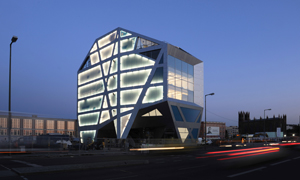 Located beneath the building – in between the Humboldt Box’s four plinths – is a weather-protected forecourt and waiting area for visitors. A large outdoor staircase or rather a gangway leads directly from the outside to the first floor, the heart of the Humboldt Box. Here we find the agora, a foyer framed with seating steps that serves as the starting point for visits to the exhibition areas. The agora is also a good event location, a use that the designers encourage. The outdoor staircase on the ground floor begins with the agora (first floor) and continues as a visitors’ stairway for touring the exhibition levels on the second and third storeys, making it easy for viewers to find their way around. The tour ends on the third floor, in the reading lounge with a view of the Lustgarten and the Berlin Cathedral. The fourth floor will be used for events. Moveable glass wall elements enable a variety of spatial situations. A café/restaurant is located on the fifth floor, including two panorama terraces: to the south overlooking the Humboldt Forum construction site and to the north, with a view of Unter den Linden that reaches all the way to the Brandenburg Gate, the Lustgarten and Alexanderplatz. If the glass elements in the façade are left completely open in good weather, the interior will flow directly over the two panorama terraces. Located beneath the building – in between the Humboldt Box’s four plinths – is a weather-protected forecourt and waiting area for visitors. A large outdoor staircase or rather a gangway leads directly from the outside to the first floor, the heart of the Humboldt Box. Here we find the agora, a foyer framed with seating steps that serves as the starting point for visits to the exhibition areas. The agora is also a good event location, a use that the designers encourage. The outdoor staircase on the ground floor begins with the agora (first floor) and continues as a visitors’ stairway for touring the exhibition levels on the second and third storeys, making it easy for viewers to find their way around. The tour ends on the third floor, in the reading lounge with a view of the Lustgarten and the Berlin Cathedral. The fourth floor will be used for events. Moveable glass wall elements enable a variety of spatial situations. A café/restaurant is located on the fifth floor, including two panorama terraces: to the south overlooking the Humboldt Forum construction site and to the north, with a view of Unter den Linden that reaches all the way to the Brandenburg Gate, the Lustgarten and Alexanderplatz. If the glass elements in the façade are left completely open in good weather, the interior will flow directly over the two panorama terraces.
The Humboldt Box’s “transitory architecture” is a communicative, spatial sculpture: multi-purpose and designable levels on the inside – the final form of which is left up to the current occupant – and a sculpture with an alterable shell on the outside, born of the peculiarities of this little building lot and a precursor to the future, more sizeable Humboldt Forums construction site!
|
|
 |
 |
 |
 |
 |
 |
 |
LOCATION |
 |
|
|
 |
|
 |
 |
 |

|
 |

|
Continent |
|
 |
|
Nation |
|
 |
|
Land |
|
 |
|
Town |
|
 |
|
Neighborhoods |
|
 |
|
Isle |
|
 |
|
Address |
|
 |
|
|
|
 |
|
Telephone |
|
 |
|
Website |
|
 |
|
E-mail |
|
 |
|
 |
 |
 |
 |
MAP |
 |
|
|
 |
|
 |
 |
 |
| |
 |
|
 |
 |
 |
 |
WEBCAM |
 |
|
|
 |
|
 |
 |
 |
| |
 |
|
 |
 |
 |
 |
|
TYPOLOGY |
 |
|
|
 |
|
 |
 |
 |
Main |
 |
|
 |
ARCHITECTURE | Buildings for travel and tourism
Information and reception centres
Other architectural structures
Pavilions, kiosks, facilities
| |
|
|
 |
|
Additional |
 |
|
 |
ARCHITECTURE | Buildings for cultural activities
Art galleries and exhibition areas
Commercial buildings
Bars, cafeterias
Restaurants
Urban equipment and structures for public areas
Panoramic structures, belvederes
| |
 |
 |
 |
 |
CHRONOLOGY |
 |
|
|
 |
|
 |
 |
 |
Project |
 |
|
 |
| 
 |
2011
project winner of competition
|
|
Realisation |
 |
|
 |
| 
 |
2011 |
|
 |
 |
 |
 |
CLIENT |
 |
|
|
 |
|
 |
 |
 |
| |
 |
|
 |
 |
 |
 |
STRUCTURES |
 |
|
|
 |
|
 |
 |
 |
| |
 |
| Krone Hamann Reinke Ingenieurbüro |
|
 |
 |
 |
 |
STAFF |
 |
|
|
 |
|
 |
 |
 |
Project  |
 |
| KSV Krüger Schuberth Vandreike |
|
|
 |
|
|
 |
|
Project leader |
 |
gassert a+i berlin
architekten + ingenieure
Kurt R. Gassert |
|
Design concept |
 |
| Bertram Vandreike, Christiane Schuberth, Torsten Krüger |
|
Construction supervision |
 |
|
Consultant |
 |
Winter Ingenieure
Ingenieurgesellschaft Zimmermann für Gebäude- und Labortechnik |
|
Lighting engineer |
 |
|
Computerization |
 |
|
Facades consultant |
 |
Wagner + Partner
Volker Wagner |
|
 |
 |
 |
 |
CREDITS |
 |
|
|
 |
|
 |
 |
 |
| |
 |
Photo © Karsten Pagel and KSV
Drawings © KSV Krüger Schuberth Vandreike
Text edited by KSV Krüger Schuberth Vandreike
Courtesy by KSV Krüger Schuberth Vandreike
|
|
 |
  |
 |
|
|